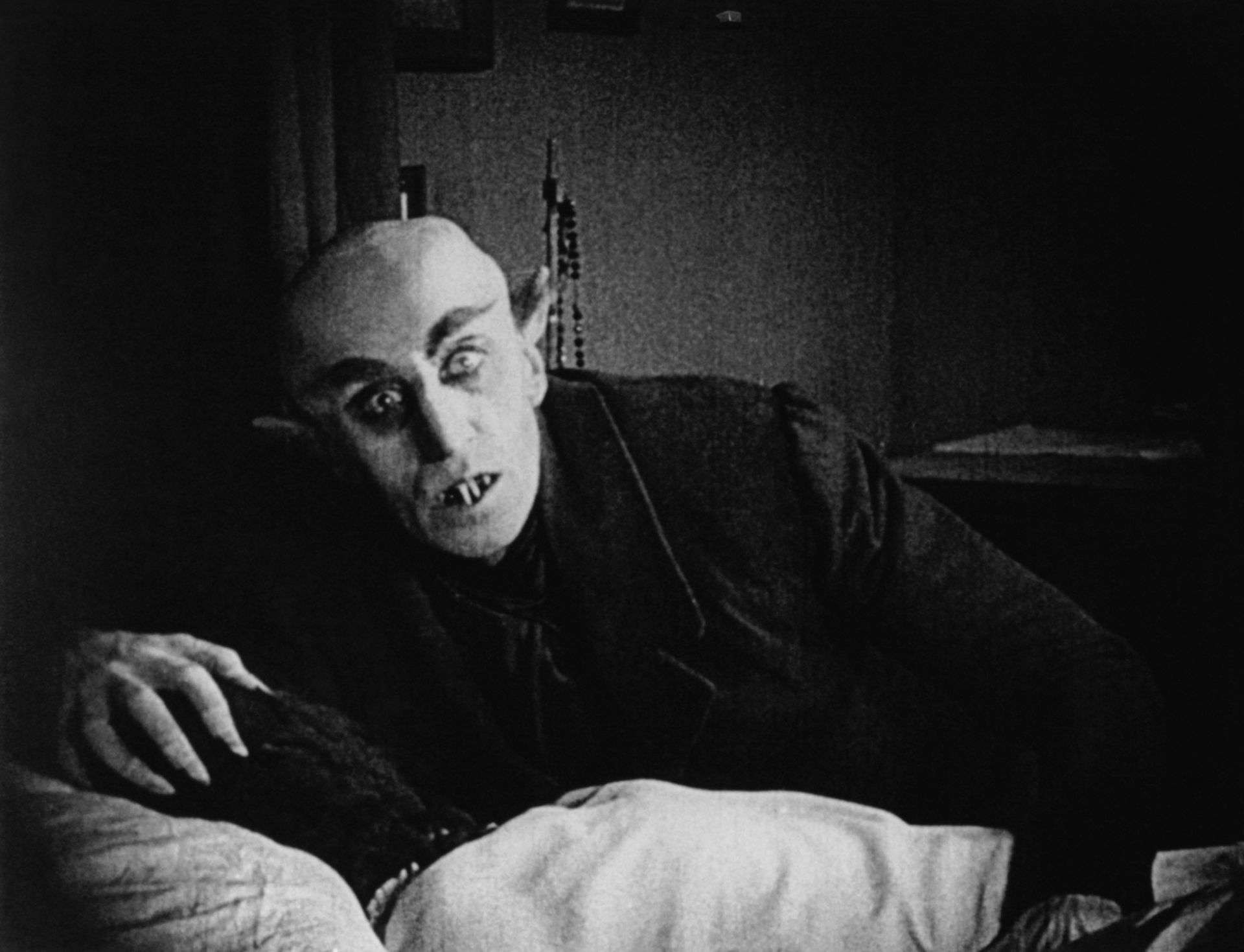Background photo: media.vanityfair.com
Nosferatu vs. Dracula
The answer is quite simple: Nosferatu was an unauthorized adaptation of Dracula that created a cult of its own. The three on-screen adaptations include the 1922 film Nosferatu: A Symphony of Horror, Nosferatu the Vampyre made in 1979, and the newest adaptation by Robert Eggers, Nosferatu (2024). While Nosferatu and Dracula are technically the same creature, there are many differences between the characters. Nosferatu is a creepy, unsettling, rodent-like beast of the night. He has long nails, sharp front teeth, and a hunched back. He is not the charming vampire like Count Dracula. Nosferatu embodies the true meaning of eternal life: its dark side.

Nosferatu: A Symphony of Horror (1922)
When the first film premiered in 1922, it shocked audiences to their core. Its German Expressionist style and provocative themes made it too intense for the viewers. Actor Max Schreck portrayed Count Orlok (Nosferatu) as a terrifying, lustful vampire who sought to wreak havoc on the people of Wisborg. The storyline follows Thomas Hutter, a naive estate agent sent to Transylvania to come to an agreement with a client (Count Orlok), leaving behind his beloved wife, Ellen. As he reaches the Carpathian Basin, the local people warn him not to continue. They advise him not to visit Count Orlok, but Hutter ignores their pleas and heads to the castle. Thomas arrives at the estate and is welcomed by Nosferatu, the vampire himself.
Chaos unfolds when the Count learns about Hutter’s wife, Ellen, and becomes immediately captivated by her. Nosferatu develops an obsession with her, even appearing in her dreams. He later decides to purchase the townhouses opposite the couple’s residence in Wisborg. On his journey, he carries with him a deadly plague spread by rats, becoming the harbinger of death. The film ends with the innocent Ellen sacrificing herself to end the horrors Nosferatu brought upon the town and to stop his reign of terror once and for all. Nosferatu meets his demise through his own desire for blood when the sun comes up as he feeds on Ellen, making lust his downfall. The film was eventually banned in certain places due to its horrific content and copyright issues. Thankfully, a few surviving copies were preserved, helping Nosferatu to become a classic in the horror genre.

Nosferatu the Vampyre (1979)
The storyline remains largely the same as the 1922 version, with only a few small changes. In this adaptation, Nosferatu is referred to as Count Dracula, and Ellen is renamed Lucy. This alteration creates some confusion but ultimately fuses the two stories together. With remarkable cinematography, Werner Herzog creates a more modern interpretation of Nosferatu while staying faithful to the original. Isabelle Adjani’s portrayal of Ellen, or in this version, Lucy, adds a new depth to her character, presenting her as an intelligent and calculating woman.

Nosferatu (2024)
The most anticipated remake of the horror classic, Nosferatu (2024), directed by Robert Eggers, brings Nosferatu back into pop culture, creating a version for the new generation. The film stars Lily-Rose Depp as Ellen Hutter, Nicholas Hoult as Thomas Hutter, and, most notably, Bill Skarsgård as Count Orlok. This film represents a new wave of gothic cinema, elevating horror to another level. It remains faithful to the original storyline while focusing on the cinematography and visual aesthetics of the cult classic. The film does justice to the original, and although there are a few questionable aspects (Bill Skarsgård’s Romanian accent) it can be considered the most well-executed adaptation of the story of Nosferatu.

The Occult and Biblical References
It is important to note that Nosferatu is no ordinary vampire story. The films are filled with references to the Bible and occultism. The first film, created after World War I, coincided with the rise of spiritualism and occultism at that time. Themes such as blood sacrifice, cryptic messages, and Enochian symbols appear throughout the film. Albin Grau, the producer of the original film, was responsible for most of the occult elements, as he himself was a practicing occultist, even a member of the magical order Fraternitas Saturni.
Director Robert Eggers placed even heavier emphasis on folklore and occult symbolism in his adaptation. The story’s setting around Christmas time, its themes of good versus evil, and its Christian imagery all connect the story to Christianity. Although it remains a controversial topic whether Nosferatu, with its depiction of human sacrifice, portrayal of faith, and references to the original sin, is a mockery of Christianity or a genuinely Christian story, one thing is certain: these elements make the film even more engrossing and captivating.
The story of Nosferatu lives on, inspiring filmmakers and remaining a timeless work of horror. Hopefully, the future will bring many more adaptations of this masterpiece: every generation should have its own terrifying Nosferatu.





